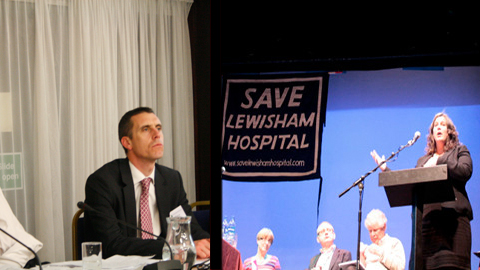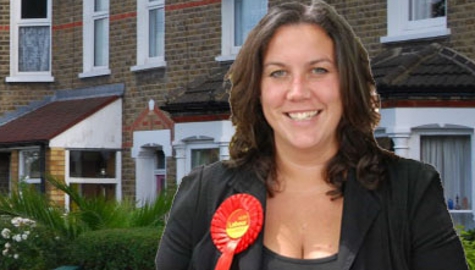As the controversy over the proposed closure of Lewisham A&E and maternity units continues, Eastlondonlines has invited Heidi Alexander, the MP for Lewisham East, who opposes the closure and the Office of the Trust Special Administrator, which has drawn up the plans, each to present their side of the case.
Heidi Alexander, Member of Parliament for Lewisham East:
As a newly-elected MP two and a half years ago, I felt incredibly proud and privileged to be given the chance to represent the residents of Lewisham in parliament.
The way in which our community has come together to fight the proposed closure of the A&E and maternity services at our local hospital has only served to reinforce that view.
With 22,000 people signing an online petition, thousands more signing in person and over 10,000 people joining together at a peaceful demo at the end of November, it is clear that our corner of south-east London is not going to stand for this brutal attack on our local NHS.
Lewisham Hospital is a busy hospital; its A&E treats 115,000 people every year. Over 4,000 babies are born there annually. Not everything is perfect but it is a valued and necessary part of the health service.
The proposals on the table at the moment would see over half of the buildings at Lewisham Hospital sold off. To what end? To spend money on other hospitals so that they pick up the work that Lewisham is already doing well. Where is the sense in that?
Everyone knows the reason services at Lewisham Hospital have been earmarked for closure is to deal with financial problems at neighbouring hospitals. Why should Lewisham Hospital and Lewisham residents end up paying the price?
I’m not against change in the NHS but change must be driven by the health needs of patients and not an accountant’s bottom line.
The current proposals are based on inaccurate data and flawed assumptions. I am opposed to the cuts to our local services and will do everything in my power to stop them.
The Prime Minister once said he wanted to retain essential services in places like Lewisham; he even named Lewisham as one of 29 hospitals he would be prepared to get into a bare-knuckle fight over. How times have changed. If the Prime Minister wants a fight, we’ll give him one.
The Office of the Trust Special Administrator, South London Healthcare NHS Trust:
A lot has been written and said about the proposed changes to health services in south-east London, including how they impact on Lewisham Hospital.
Overall, if the recommendations that are being proposed are accepted, we believe that it will have a positive impact on the health of people in south-east London, including people who live in Lewisham.
But how can we be so sure?
Many people in Lewisham may not know that if you had a heart attack in Lewisham today, the ambulance taking you to hospital would drive straight past Lewisham Hospital.
If you had a serious road traffic accident in Lewisham today, involving severe physical injury or a very serious head injury, the ambulance taking you to hospital would not take you to Lewisham Hospital. And if you were having a stroke today, a clot in your brain that could cause brain damage or death, the ambulance taking you to hospital would not take you to Lewisham Hospital either.
So where would these ambulances go?
For stroke and major injury, the ambulance would take you to King’s College Hospital in Denmark Hill, Southwark. People having a heart attack would be taken to either King’s College Hospital or to the Princess Royal University Hospital in Bromley.
By creating these specialist centres, the NHS in south-east London has saved lives because the expertise to treat these very serious conditions has been concentrated into fewer hospitals.
On average, patients have needed to travel a bit further to get to these hospitals. But even with those additional few minutes in a blue-light ambulance factored in, patients have had better results overall because the NHS is providing these specialist services in fewer hospitals.
These specialist centres were created some years ago, after a lot of public consultation and a lot of concern from patients about longer journey times to hospital. It is now acknowledged that the creation of such centres has saved lives and improved the quality of clinical treatment overall.
These are the ideas that underpin the draft proposal to centralise accident and emergency units in south-east London at four hospitals, not five.
We aim to have a senior-level doctor on duty in our A&E departments for 18 out of every 24 hours of every day of the year. No hospital in south-east London achieves that target consistently. If these changes are accepted, we believe all our A&E departments will be able to do so in the future.
Most patients, about 75 per cent, who currently use the A&E at Lewisham Hospital will still be able to be treated at its enhanced urgent care centre. But those needing the most critical emergency care will be taken by blue-light ambulance to a hospital that is the same distance or just a short distance further away than now. The result will be more saved lives.
Please give us your views before the end of the consultation, as your views matter and will be taken into account before the final report is sent to the Secretary of State in January.








This is disingenuous from the TSA (again) – the proportion of emergency cases from Lewisham requiring ‘clot busting’ for heart attack or stroke, or major trauma, is less than 5% of the total. There is simply no evidence that the other 95% can be better treated at super-specialist centres. Longer travel times to neighbouring A&Es would result in worse outcomes for the vast majority, if the local A&E were to close.
Disingenuous, too, is the claim that local clinicians support these proposals. Some were invited to clinical advisory panels arranged by the TSA, but when the real agenda became clear – the closure of acute services at Lewisham – no votes were taken and dissent was not even recorded.
The TSA has stated repeatedly the he has ‘worked closely’ with clinicians to develop his proposals. That has been exposed as a sham.
As a parent of three small children, these proposals and incorrect assumptions being bandied around by the TSA are very frightening indeed. They can use as much jargon as they like to try and disguise this, but they are basically trying to remove vital A&E and Maternity services from a whole London Borough. Anybody with an ounce of common sense can see that their proposals for Lewisham are just plain dangerous. Their ill thought out plans for low risk maternity provision are deeply flawed. Birth is unpredictable. Many “low-risk” births can suddenly become emergencies during labour. Matthew Kershaw seems to think it’s acceptable for women to be put on long ambulance journeys at this critical point rather than straight into an operating theatre. The days of women or babies dying at childbirth should be long behind us. Lewisham Hospital provides an excellent service, is financially well run and is massively needed by our community. It should be held up as a successful NHS case study and not destroyed wilfully like this.
Darent Valley Hospital had to close its doors last week for over 6 hours mainly due to overwhelming numbers of patients coming into the A and E department. This has been put down to the closure of Queen Mary’s Hospital A & E at Sidcup (part of the ‘toxic’ healthcare trust) Ambulances had to be diverted further afield in all directions.
This situation will obviously occur at Queen Elizabeth Hospital in due course, only greatly magnified, as the ‘knock on’ effect of Lewisham A & E closure takes a grip. What will be the consequences of the delays in emergency treatment of patients being trawled around south london and kent trying to find a hospital with not only a proper A & e DEPT, but attached to a hospital which has not had to close its doors due to being full to capacity.